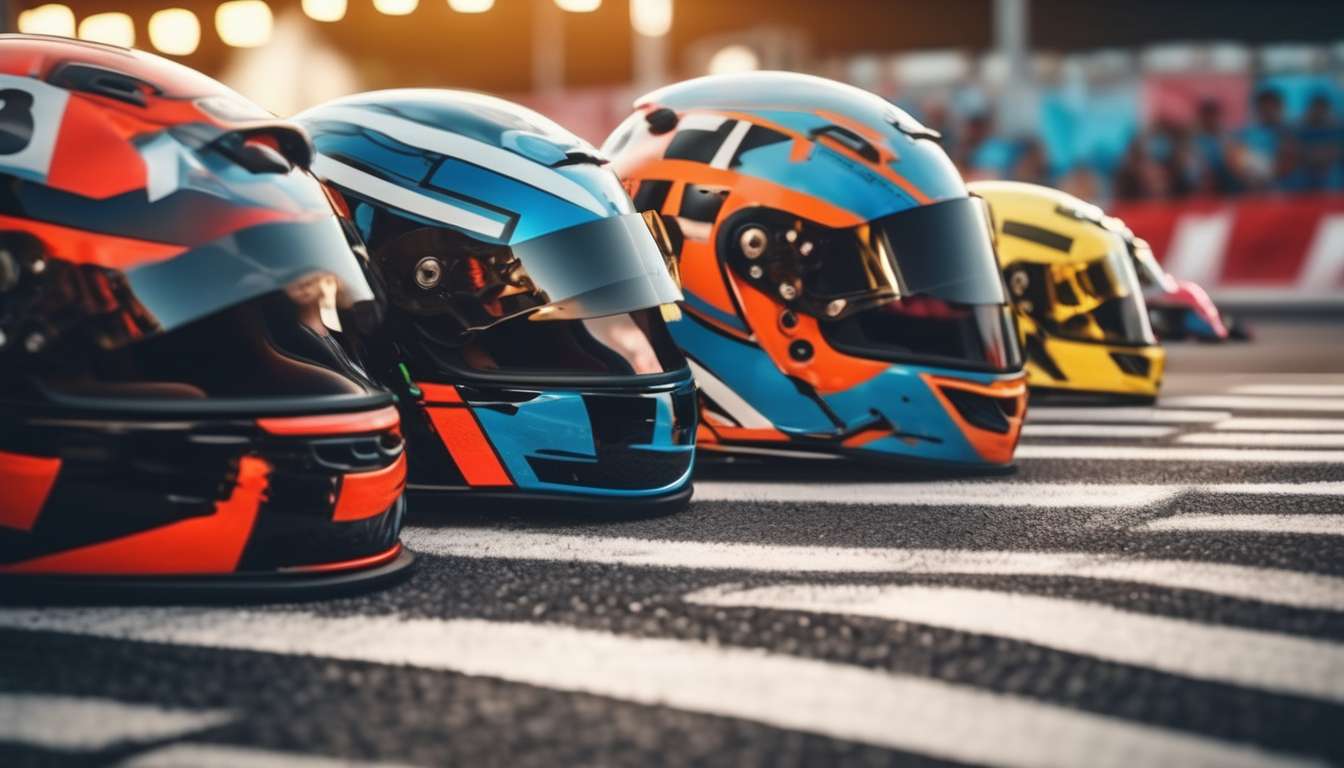As passionate enthusiasts of the racing world, we understand that diving into this exhilarating sport can sometimes feel like learning a new language. Whether we’re cheering from the stands, tuning in from home, or even participating ourselves, having a firm grasp on the terminology enhances our experience and deepens our appreciation for the sport.
In this guide, we aim to demystify the essential vocabulary that every racing fan, whether novice or seasoned, should know. Together, we’ll explore:
- The terms that define the fast-paced action on the track
- The strategies employed by teams
- The technologies that propel vehicles to breathtaking speeds
Our journey through this linguistic landscape will empower us to:
- Engage more fully with the races we love
- Discuss them with confidence
- Connect with fellow fans on a more profound level
Let’s rev up our engines and dive into the thrilling world of racing terminology.
Track Terminology
Let’s dive into the essential terms you’ll need to know when discussing different types of racing tracks.
Track:
The "track" itself is the heart of any race. It’s where the action unfolds, and understanding its nuances helps us feel more connected to the race’s rhythm. Each track has unique characteristics, from the length of its straightaways to the tightness of its corners, impacting how racers and their teams strategize.
Pit Crew:
The "pit crew" plays a crucial role during the race. These highly skilled individuals ensure quick and efficient stops, handling everything from refueling to tire changes. Their expertise can make or break a team’s performance, especially on tracks where aerodynamics are paramount.
Aerodynamics:
Speaking of "aerodynamics," this term refers to how air interacts with the vehicle as it speeds along the track. On different tracks, aerodynamic setups are adjusted to optimize speed and control.
By understanding these terms, we become part of the racing community, cheering alongside those who share our passion.
Vehicle Components
Every vehicle component plays a vital role in pushing racing cars to their limits on the track.
As a community of racing enthusiasts, we know that each part of the vehicle is crucial to achieving peak performance. Our pit crew constantly fine-tunes these components, ensuring that everything operates seamlessly and efficiently. This connection between driver and crew fosters a sense of unity, making us feel like we’re part of something bigger than ourselves.
Aerodynamics is a key factor in racing success, influencing how our cars slice through the air with precision.
The design of our spoilers and winglets helps maintain grip and stability at high speeds, giving us an edge on the track.
Meanwhile, our engines roar with power, expertly assembled to deliver lightning-fast acceleration.
Brakes must be reliable and responsive, allowing us to corner with confidence.
Each of these components, working in harmony, fuels our passion and commitment to the sport we love.
Racing Strategies
To outmaneuver our competitors on the track, we rely on a combination of split-second decision-making and meticulously planned racing strategies. Our team’s unity and trust in each other allow us to execute these strategies with precision.
We harness the power of aerodynamics to maximize our speed and efficiency. This involves:
- Reducing drag
- Optimizing airflow
These elements are crucial for those moments when every second counts.
Our pit crew plays an essential role in our success. They’re the backbone of our strategy, ensuring:
- Our car is in peak condition
- We make the most of every pit stop
Their swift actions and seamless teamwork can mean the difference between victory and defeat, shaving valuable seconds off our time.
As we navigate the track, we constantly adapt, reading our rivals’ moves and adjusting our tactics. Together, we share:
- A common goal
- A sense of belonging
Our collective effort propels us toward the finish line and, hopefully, to the winner’s podium.
Driver Techniques
Mastering driver techniques requires us to blend intuitive skill with calculated maneuvers to gain every possible advantage on the track.
We need to feel the rhythm of the race, adjusting our style to match the conditions, whether it’s a sharp corner or a straight stretch. Understanding how aerodynamics affect our speed and control is crucial; we tweak our positioning to reduce drag and improve performance.
Our connection with the car is vital. We sense when to accelerate and when to brake, maintaining balance even at high speeds. Communication with our pit crew is essential, ensuring our strategy aligns with real-time developments. Together, we become a cohesive unit, each member playing their part seamlessly.
As we navigate the track, we embrace the camaraderie and shared passion that unite us. Every maneuver is a testament to our dedication and teamwork.
By mastering these techniques, we don’t just drive; we belong to a community striving for excellence.
Pit Crew Operations
Our Pit Crew’s Impact
Our pit crew’s precision and speed during pit stops can make all the difference in a race. We operate like a well-oiled machine, with each member knowing their role to ensure the car’s back on track in record time. Teamwork is crucial because every second counts.
Beyond Basic Tasks
We’re not just changing tires or refueling; we are also:
- Fine-tuning aerodynamics
- Making adjustments that can shave seconds off lap times
Unsung Heroes of the Track
On the track, where speed defines success, we’re the unsung heroes, working behind the scenes to support our driver. Our pit crew’s dedication creates a sense of unity and belonging. We feel the adrenaline as we prepare for each stop, communicating seamlessly to execute flawless operations. It’s more than mechanics; it’s a synchronized dance of skill and timing.
Commitment to Excellence
Each pit stop is a testament to our commitment to excellence. Together, we ensure our car’s optimum performance, striving for victory. We’re more than a team; we’re a racing family.
Flag Meanings
Flags play a crucial role in racing, conveying essential information that can alter the course of a race. They create a shared understanding among drivers, pit crews, and track officials.
Key Racing Flags and Their Meanings:
-
Yellow Flag:
- Indicates a caution on the track.
- Urges drivers to slow down and avoid overtaking.
- Provides pit crews time to strategize and prepare for potential changes.
-
Red Flag:
- Means the race is stopped.
- Usually due to hazardous conditions or accidents.
- Allows everyone to regroup safely.
-
Green Flag:
- Signals the start or restart of the race.
- Sends adrenaline rushing as drivers aim to optimize aerodynamics for speed.
-
Checkered Flag:
- Marks the finish of the race.
- Celebrates a shared victory for everyone involved.
-
Blue Flag:
- Instructs slower cars to yield.
- Ensures faster cars maintain their momentum.
Together, these flags keep the race orderly and thrilling, making everyone part of a dynamic, synchronized team on the track.
Aerodynamics in Racing
In racing, optimizing aerodynamics transforms every vehicle into a finely-tuned machine that slices through the air with precision and speed.
As a team, we understand that every detail counts—every curve, every angle, and every surface can make or break our performance on the track. Aerodynamics isn’t just about speed; it’s about achieving perfect harmony between the car and the air around it. This synergy reduces drag and increases downforce, allowing us to take those corners faster and safer.
Our pit crew plays a crucial role in this aerodynamic dance. They’re not just mechanics; they’re part of our racing family, ensuring every component is primed for peak aerodynamic efficiency. During pit stops, they make swift adjustments, tweaking wings and spoilers to adapt to changing track conditions.
Together, we strive for aerodynamic perfection, knowing that each second saved brings us closer to victory. We’re not just racing cars; we’re crafting masterpieces of speed and precision.
Racing Regulations
Racing regulations govern every aspect of our sport, ensuring fairness and safety while pushing the limits of innovation and competition. These rules create the foundation for our beloved racing community.
On the track, regulations dictate everything from car specifications to the conduct of drivers, ensuring a level playing field. Our pit crew must adhere to strict guidelines during pit stops, balancing speed with precision to avoid penalties that could cost us the race.
Aerodynamics play a crucial role, as regulations specify dimensions and modifications allowed on our vehicles. We’re constantly fine-tuning our designs within these boundaries to gain every possible advantage without breaching the rules.
Being part of this community means embracing the regulations that bind us together. They challenge us to innovate responsibly, ensuring that every race is as thrilling and fair as the last.
Together, we thrive under these shared standards.
What are the historical origins of popular racing terms?
We’ve always been fascinated by the historical origins of popular racing terms. They offer a glimpse into the rich traditions and evolution of the sport.
Understanding where these terms come from adds depth to our appreciation of racing. Whether it’s terms like "photo finish" or "pole position," each one carries a story that connects us to the past and keeps the spirit of racing alive today.
How has technology influenced the evolution of racing terminology?
Technology has significantly influenced the evolution of racing terminology.
Innovations like telemetry and data analysis have introduced new terms such as:
- Aero mapping
- Power unit optimization
These advancements continuously shape how we describe and understand the intricacies of racing.
As fans, we embrace these changes and eagerly learn the latest jargon to stay connected to the ever-evolving world of motorsports.
What are some common misconceptions about racing jargon?
Common Misconceptions About Racing Jargon
Some people believe that racing jargon is meant only for experts. In reality, with a little understanding, anyone can grasp the basics.
Another misconception is that all racing terms are complex and hard to remember. However, many terms are straightforward once you get the hang of them.
Don’t let these misconceptions deter you from enjoying and learning about the exciting world of racing!
Conclusion
Mastering Racing Terminology
As you navigate the exhilarating world of racing, mastering the essential terminology is key to understanding the dynamics of the sport. Familiarizing yourself with these fundamentals will not only enhance your appreciation for the sport but also deepen your insights into competitive racing.
Key Aspects of Racing:
-
Track Nuances:
- Understanding the different types of tracks and their specific challenges can give you a strategic advantage.
-
Vehicle Intricacies:
- Knowing the technical details of racing vehicles, from engine specifications to aerodynamics, is crucial for optimizing performance.
-
Strategic Maneuvers:
- Mastering overtaking techniques and pit stop strategies can significantly influence the race’s outcome.
-
Flag Signals:
- Recognizing and reacting to flag signals ensures safety and compliance with race regulations.
By embracing these elements, you’ll keep pushing the limits and truly enjoy the thrill of the race!



